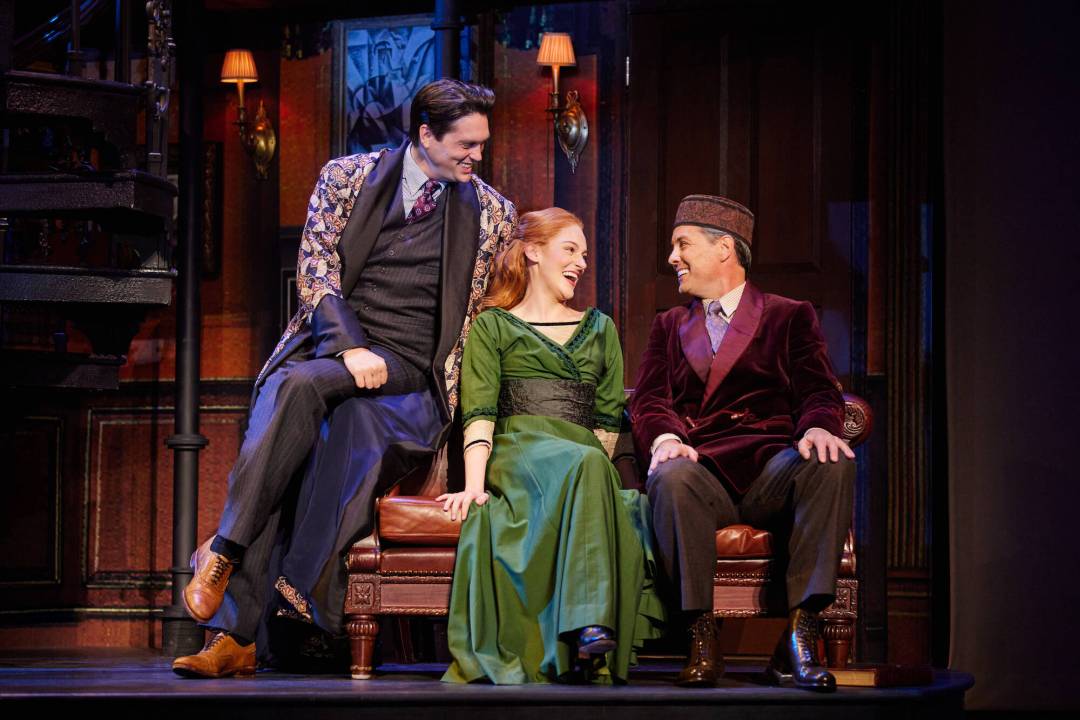My Fair Lady stuns on stage with robust orchestrations, beautiful costumes, sweeping choreography—and a flat set?
I was lucky to win a lottery ticket to My Fair Lady on tour, and I was thrilled to see this classic come to life on stage. I’m not usually very into Golden Age musicals, but I’m very open minded and like to give things a chance. I did enjoy the film adaptation with Audrey Hepburn (as controversial as it might be), so my hopes were high for the revival of the stage production.
For those keeping score at home, this is the non-equity touring production that started in the fall of 2022. It is—in theory—the same revival tour as the Lincoln Center production from 2018. I’m not sure if there have been changes from the revival tour to this non-equity tour, but it did have some quirks. The biggest change that seems to have been made is that, as far as I’ve heard, the original Lincoln Center revival had a turntable, and this touring production did not. This seemed to affect some of the set changes and overall scenic design.
This production was a wonderful opportunity to hear the Lerner and Loewe score live. I think the orchestrations are one of the strongest parts of My Fair Lady, and this production really showcased that.
I also always love the narrative arch of a disgruntled man and a stubborn woman having to work together until they realize they’re in love. My Fair Lady, though adapted from the play Pygmalion, is one of the classic tales that uses this dynamic as well as incorporating the rags to riches narrative arch.
I enjoyed Madeline Powell‘s performance as Eliza Doolittle. Though there were times her accent was very challenging, and it was hard to even tell what she was saying, it was hard to tell if that was intentional for the character. It’s a point to be made that Eliza has a difficult accent, but I feel as an audience member, it shouldn’t be so hard to understand you lose about half the opening dialogue. However, I enjoyed her rendition of “I Could Have Danced All Night.”
Jonathan Grunert‘s performance as Professor Henry Higgins stood out in this production. Though seemingly cast as a younger Higgins, Grunert is charming and plays Higgins with much gusto. To me, casting a younger Higgins makes the romance between Eliza and Higgins a bit more believable. Though he does say lines about being an old bachelor, I don’t think this really took anything away from the character. It’s equally possible to be a pretentious young professor as it is to be a pretentious middle-aged professor. Overall, I really enjoyed Grunert’s portrayal.
Nathan Haltiwanger is another standout as Freddy Eysenford-Hill. He charmingly dotes on Eliza and delivers a fantastic “On the Street Where You Live.” I wish you got to see his talents a little bit more, but it is no doubt that Haltiwanger is a rising star. I was disappointed how little Freddy appears in the musical because he is so enthusiastic. Nonetheless, Haltiwanger grabs the spotlight in his featured scenes.
I really struggled with the sets and the visual design of this show. My Fair Lady feels like it should be a luxurious and grand production; on the contrary, the sets were small and unassuming. The buildings were all two-dimensional like they were made of cardboard, and it felt very much like something you would see in a school production. Perhaps the most intricate set was the home of Henry Higgins, which included a two-story set piece, however, even that was not very detailed. It was apparent, even from far away, that Higgins’ bookshelves were merely painted on. The scenic design felt a little cheap and gave a professional performance the appearance of a school play.
Overall, this production is a bit lukewarm. The show is strong through act I and quickly declines in the second act. The story feels like it comes to a halt after Eliza and Higgins attend the ball at the top of act ii, and the goal they set out to accomplish is complete. The second act is heavy with side characters and drawn out musical numbers to fill the time.
I’m not sure this is a production I would revisit, but I am glad I had the opportunity to see it staged. When seeing revivals of this type, I try to examine it from a lens that this was essentially written for a different audience than the audience viewing it today. Even still it brings these types of revivals into question of time and place. Revivals can be so subjective to the audience you have. I can see how My Fair Lady was once very popular, but it’s not exactly the type of musical we’re used to seeing in the present day, so it can be challenging to see eye to eye with it.
My Fair Lady is a musical based on George Bernard Shaw’s 1913 play Pygmalion, with a book and lyrics by Alan Jay Lerner and music by Frederick Loewe. The musical’s 1956 Broadway production was a notable critical and popular success, winning six Tony Awards, including Best Musical. It set a record for the longest run of any musical on Broadway up to that time.
